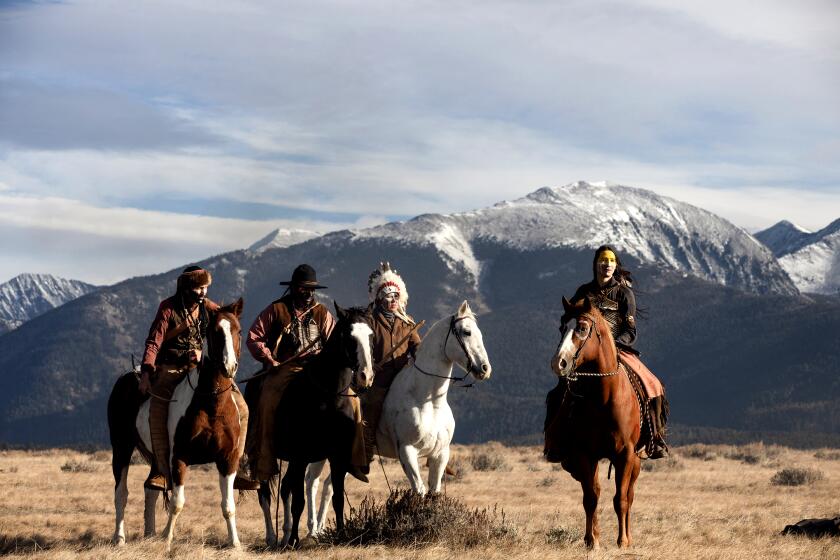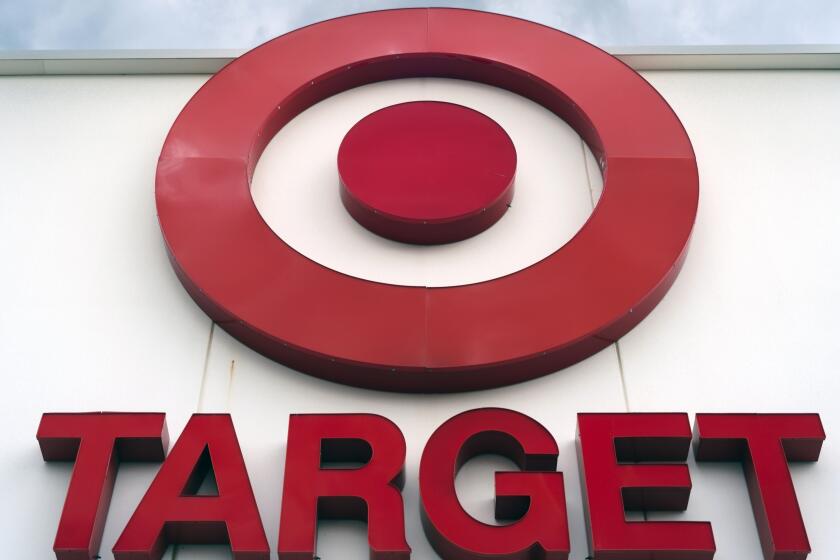Trying to buy a greener conscience
- Share via
The Oscar-winning film “An Inconvenient Truth” touted itself as the world’s first carbon-neutral documentary.
The producers said that every ounce of carbon emitted during production -- from jet travel, electricity for filming and gasoline for cars and trucks -- was counterbalanced by reducing emissions somewhere else in the world. It only made sense that a film about the perils of global warming wouldn’t contribute to the problem.
Co-producer Lesley Chilcott used an online calculator to estimate that shooting the film used 41.4 tons of carbon dioxide and paid a middleman, a company called Native Energy, $12 a ton, or $496.80, to broker a deal to cut greenhouse gases elsewhere. The film’s distributors later made a similar payment to neutralize carbon dioxide from the marketing of the movie.
It was a ridiculously good deal with one problem: So far, it has not led to any additional emissions reductions.
Beneath the feel-good simplicity of buying your way to carbon neutrality is a growing concern that the idea is more hype than solution.
According to Native Energy, money from “An Inconvenient Truth,” along with payments from others trying to neutralize their emissions, went to the developers of a methane collector on a Pennsylvanian farm and three wind turbines in an Alaskan village.
As it turned out, both projects had already been designed and financed, and the contributions from Native Energy covered only a minor fraction of their costs. “If you really believe you’re carbon neutral, you’re kidding yourself,” said Gregg Marland, a fossil-fuel pollution expert at Oak Ridge National Laboratory in Tennessee who has been watching the evolution of the new carbon markets. “You can’t get out of it that easily.”
The race to save the planet from global warming has spawned a budding industry of middlemen selling environmental salvation at bargain prices.
The companies take millions of dollars collected from their customers and funnel them into carbon-cutting projects, such as tree farms in Ecuador, windmills in Minnesota and no-till fields in Iowa.
In return, customers get to claim the reductions, known as voluntary carbon offsets, as their own. For less than $100 a year, even a Hummer can be pollution-free -- at least on paper.
Driven by guilt, public relations or genuine concern over global warming, tens of thousands of people have purchased offsets to zero out their carbon impact on the planet.
“It made me feel better about driving my car,” said Nicky Tenpas, a 29-year-old occupational therapist from Hermosa Beach, who bought offsets to neutralize emissions from the Jeep she always wanted.
The star of “An Inconvenient Truth,” former Vice President Al Gore, says he and his family are carbon neutral, as are Dave Matthews Band concerts and Coldplay albums. The travel websites Expedia and Travelocity now offer passengers the option of counteracting their flights, and Rupert Murdoch promises that his entire News Corp. will be carbon neutral by 2010, largely through the purchase of offsets.
Offset companies stress that they are not a cure-all for the world’s greenhouse gas emissions, which are equivalent to 54 billion tons of carbon dioxide each year.
Tom Boucher, chief executive of Native Energy, said people should first reduce their energy consumption and waste, and then buy offsets -- “the only way to really get to zero unless you stop driving, stop traveling.”
But the industry is clouded by an approach to carbon accounting that makes it easy to claim reductions that didn’t occur. Many projects that have received money from offset companies would have reduced emissions by the same amount anyway.
The growing popularity of offsets has now prompted the Federal Trade Commission to begin looking into the $55-million-a-year industry.
“Everybody would like to find happy-face, win-win solutions that don’t cost anything,” said Robert Stavins, an environmental economist at Harvard University. “Unfortunately, they don’t exist.”
Selling clean air
In the rolling hills of southwestern Pennsylvania, outside the town of Berlin, Dave Van Gilder’s family has been raising cows for four decades. He and his twin sons, Jason and Justin, tend to their 400 Holsteins while his wife, Connie, keeps the books.
The smell of manure has long been the sweet exhaust of a dairy farm running full tilt.
Millions of pounds of cow excrement over the decades were funneled from the barns to a 3.3-million-gallon lagoon, where it decayed, burping invisible clouds of the potent greenhouse gas methane.
In the days of Van Gilder’s father, nobody cared about the greenhouse gases.
But things began to change a few years ago. Van Gilder didn’t know it, but his lagoon had become an economic opportunity.
A local congressman urged him to apply for a state alternative energy grant to build a system that would capture methane from cow manure and burn it to generate electricity.
The whole project, known as a methane digester, would cost about $750,000 -- $631,000 of it coming from the state and the U.S. Department of Agriculture.
Van Gilder had to make up the difference, but he figured he could earn that back -- and in several years start making money -- by supplying electricity for the farm and selling the excess to the local utility.
A year before construction began, Van Gilder was contacted by Native Energy, which wanted to buy his emissions reduction, along with the reductions of others who had won state energy grants.
Van Gilder had never heard of the company or the idea of selling clean air.
Nothing came of his discussions with the company until construction started on the massive tank for heating manure. He gladly signed a contract to sell Native Energy 29,000 tons in carbon dioxide reductions -- the company’s estimate of how much greenhouse gas the digester will keep out of the atmosphere over the next 20 years.
“There wasn’t a lot of negotiation,” said Van Gilder, who was happy to accept whatever the company was offering.
Family members said the contract prohibited them from disclosing the payment, but based on a contract with another dairy farmer, signed with Native Energy, it was about $70,000, or $2.40 a ton.
Justin Van Gilder said the money had nothing to do with the family’s decision to build its methane plant. “It was a free bonus,” he said.
“We still don’t understand it all,” Connie Van Gilder said. “It’s hard for us to fathom, to see what it is doing.”
The situation was similar for the Alaska Village Electric Cooperative, a power utility for dozens of remote communities.
In early 2006, account manager Brent Petrie was at an Anchorage environmental conference talking about a windmill project that the cooperative was building in the Yup’ik Eskimo village of Kasigluk, a soggy patch of tundra on the remote Yukon-Kuskokwim Delta in western Alaska.
Rising 100 feet over the landscape, the three 100-kilowatt turbines were intended to reduce the area’s dependence on diesel generators, whose fuel must be shipped in on barges. Federal grants were covering $2.8 million of the project’s $3.1-million cost.
Petrie had barely finished his presentation when he was cornered by representatives from two brokers -- Native Energy and the Bonneville Environmental Foundation -- eager to buy the project’s offsets.
The cooperative sold 25 years of carbon dioxide reductions to Native Energy for $36,000 -- roughly $4 a ton.
Native Energy had contributed just over 1% of the total cost of the project yet claimed 100% of its carbon reductions.
“If you look at the costs of these projects, it’s a tiny, tiny fraction,” said cooperative president Meera Kohler. The payment did “not determine whether those blades turn or not.”
At best, Kohler said, the money could cover some maintenance costs.
An untapped market
Despite its relatively small role in the project, Native Energy counts the windmills as a success, demonstrating the power of carbon offsets to encourage clean energy.
“Every kilowatt-hour they produce means one fewer kilowatt-hour is generated by the diesel generators that otherwise provide power for this village,” the company’s website says.
Wind power has long been a fascination for Boucher, Native Energy’s co-founder. As an electrical engineering major in the 1970s at the University of Vermont, he built a 25-foot-high wind turbine in his parents’ backyard, carving the blades from a piece of redwood.
He later worked at a Vermont utility and helped develop one of the first wind farms in the northeast. Boucher started his own company in the 1990s to sell alternative energy but soon came upon a simpler and possibly more lucrative product: voluntary carbon offsets.
It was a new twist on an old idea.
About 30 years ago, the U.S. government began fostering emissions markets that allowed industrial polluters to buy offsets for such gases as nitrogen oxides and sulfur oxides. One of their successes has been in reducing acid rain in the Northeast.
The Europeans have recently adopted a similar model to regulate carbon dioxide emissions, allowing the continent’s dirtiest industries to buy and sell rights to spew greenhouse gases.
The key to these regulated markets is a gradually falling cap on total emissions, forcing factories to either reduce their own emissions or buy someone else’s reductions at increasing prices.
Boucher and other environmental entrepreneurs, however, believed there was an untapped market for carbon reductions: people and companies who would buy them voluntarily.
“What was coming was a way for folks to take actions against global warming,” said Boucher, a bearded 52-year-old, who has long believed that alternative energy can be competitive with cheaper power from fossil fuels.
Native Energy, based in Charlotte, Vt., was one of the first offset companies in the United States and has become one of the most respected in environmental circles.
It has sold offsets to thousands of individuals and companies, including Levi Strauss & Co. and Ben & Jerry’s. It has been big with political campaigns, providing offsets to Democratic presidential candidates Hillary Rodham Clinton and John Edwards. The producers of the 2005 film “Syriana,” which claims to be the first carbon-neutral major motion picture, bought 2,040 tons of carbon dioxide reductions from the company.
After Native Energy’s name was mentioned in the final credits for “An Inconvenient Truth,” visits to the company’s website jumped 1,100%, marketing director Billy Connelly said.
As a private company, it doesn’t report its revenue, but Connelly said he expects it will double its sales this year, reaching a total of about 1 million tons of carbon dioxide neutralized since its founding.
“Things have really taken off in the last year or two,” said Boucher. The company has about 20 employees.
Native Energy now finds itself facing competition from nearly three dozen other offset firms worldwide. Some are nonprofit, but most of the biggest are in business to make money.
In 2006, offset companies sold greenhouse gas reductions equivalent to at least 14.8 million tons of carbon dioxide, more than double the previous year, said Katherine Hamilton, carbon project manager for Ecosystem Marketplace, which tracks the industry.
Sales are expected to double again this year.
Requirements are vague
For all the money spent, nobody can say if the offsets have done much to alleviate global warming.
The problem is whether the voluntary reductions really exist. The buzzword in the industry is “additionality” -- the idea that offset purchases actually lead to additional greenhouse gas reductions.
The concept should be simple: Pay for a project, monitor its actual reductions, then claim your share.
Instead, offset companies often have vague requirements to determine if their potential investments would actually lead to additional reductions.
Native Energy says it looks for projects that need offset revenue to survive -- a difficult standard, since the projects are expensive and the offset payments are relatively small. But even if a project can stand on its own, it can still qualify for the money if it is novel or simply “not business as usual,” according to the company’s website.
That definition has allowed Native Energy and other offset companies to claim the carbon reductions from projects in which they have played minor roles. Still, Native Energy’s contract requires projects to certify that whatever offset money they receive “is a necessary component of the project’s economic viability.”
The company has struggled with whether its funding matters. Boucher said the windmills in Alaska were debated for weeks inside Native Energy since the project already had been funded by the government. “This is a case of one of the more difficult determinations,” he said.
Native Energy, he said, eventually concluded that its contribution, if used as a reserve fund for emergency repairs, was meaningful. It helps “to make sure these turbines will run as well as they can, and to further the chances that other wind farms will be built,” he said.
In the case of the methane digester, Boucher said the reductions were additional since the offset payments helped cover a significant portion of Van Gilder’s out-of-pocket expenses.
The best way to ensure additionality, according to Native Energy, is to pay a project for a decade or more of offsets while the developers are still arranging the financing.
The downside is that the carbon reductions might not occur for a decade or more.
One of Native Energy’s expected future projects is a windmill development being planned for a South Dakota Sioux reservation. Part of the offset money from “An Inconvenient Truth” has been earmarked for the $45-million project, known as the Owl Feather War Bonnet Wind Farm.
Native Energy and the developers are still negotiating, but the payment for the next 25 years of carbon reductions could be a few million dollars.
Even in this ideal case, the developer is hesitant to say that the money he will get from Native Energy is essential.
“Could we do it without it?” said Dale Osborn, head of Distributed Generation Systems Inc. in Lakewood, Colo. “Maybe. But that would require charging more for the energy or the investors accepting a lower rate of return.”
Several environmental and clean energy groups have also raised concerns about verifying projects, monitoring their actual carbon reductions and ensuring that each carbon offset is not sold more than once.
“People are trying to do the right thing,” said Peter Knight, a partner with Al Gore in Generation Investment Management, which invests in environmentally responsible companies. “It’s a new field . . . and it’s going through some growing pains.”
Price of feeling good
Without government regulation and mandatory caps on emissions, all that is left to drive offset sales is guilt and marketing. Offset companies charge what the market will bear.
“How much are you willing to spend to feel good or to impress your neighbors?” asked Marland, of Oak Ridge National Laboratory.
For Katy Hansen, a 29-year-old law school student, the answer was $429.99.
She wanted to offset the travel of the guests to her May wedding in Madison, Wis., and paid San Francisco-based offset company TerraPass Inc. to neutralize 40 tons of carbon dioxide.
“The wedding felt out of character in a way,” she said. “It was more overdone than anything in our lives.”
It was a well-intended gesture, but one that some scientists say does carry a price. Offsets are so convenient that they may foster a false sense that global warming can be easily solved when the hard and expensive work remains undone.
A United Nations panel recently concluded that actually reducing emissions to avoid the worst perils of global warming would cost trillions of dollars a year over the next several decades.
“These offsets are not addressing the problem that must be addressed now,” said James Hansen, NASA’s top climate researcher. “If we just fool around with marginal things, we will be up a creek without a paddle in the rather near future.”
Despite the imperfections of the offset market, some customers say, it still helps people think about their own responsibility for global warming.
“It’s a powerful first step,” said Davis Guggenheim, director of “An Inconvenient Truth.” “The choice of doing this rather than nothing is not a choice.”
He acknowledged the skepticism about voluntary offsets, but he added, “All of us knew when you’re doing offsets that the theoretical and symbolic quality to doing this is as important as the practical quality.”
Ethan Prochnik, a 43-year-old freelance television producer in Los Angeles, said the enormous threat of global warming means that everyone has to help in reducing emissions.
He foresees a time when a carbon tax will be factored into the price of every tomato, every pair of jeans, every computer.
Until then, offset payments are a sort of self-imposed pollution tax.
For months, Prochnik and his fiancee saved to offset a year of their lives. He finally went to the website for an Oregon company called the Climate Trust. He entered their state of residence, the size of their Montecito Heights house, their cars, their annual mileage and the number of flights they took in a year.
“It’s like a poor man’s Prius,” he said, explaining that he couldn’t afford to trade his Isuzu Rodeo SUV for a hybrid.
“It does make you feel a little better,” said his fiancee, Amber Vovola, 29.
Prochnik entered his credit card number and pressed the “enter” key. The total came to 21.22 metric tons of carbon dioxide, or $200.28.
Figuring that the website calculator didn’t cover all their pollution, he decided to buy an additional $300 in offsets, just to be safe.
--
More to Read
Inside the business of entertainment
The Wide Shot brings you news, analysis and insights on everything from streaming wars to production — and what it all means for the future.
You may occasionally receive promotional content from the Los Angeles Times.










